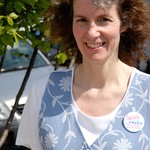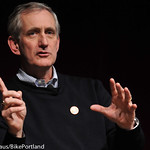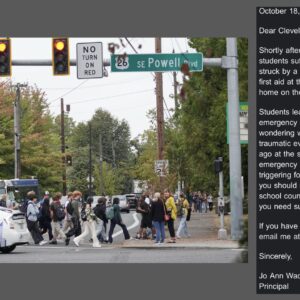“The Value of Jobs“, a coalition of Portland-area business groups that includes the Portland Business Alliance, has published its http://www.valueofjobs.com/candidate_ques/index.html for the City Council race between incumbent Amanda Fritz and her challenger Mary Nolan; and the mayoral race between Charlie Hales and Jefferson Smith.
The one question (of 15) that dealt with transportation policy, and how the candidate’s answered it, is worth noting.*
Here’s the question:
As the city’s population grows at the same time our ability to expand our existing transportation infrastructure remains limited, how will you balance the need to accommodate more trips by alternative modes of transportation while preserving access for freight and automobile mobility? Please give specific examples.
Note the language they use. They continue to assume that we will be “preserving access for freight and automobile mobility” in the future and that everything else is just an “alternative” that we must figure out how to “accomodate.” And notice how any changes to the roadway for these “alternative modes” can come only if we “expand our existing… infrastructure”. They don’t seem to understand — or they don’t want to accept — that the future will be about re-allocating existing space and using more of it to improve access for bicycles and other non-auto modes.
Now. Onto the answers.
Amanda Fritz used this question to talk about the need for new revenue. “As we seek to complete inadequate infrastructure and fill operational/maintenance funding gaps for freight, passenger and commercial autos, transit, pedestrians (including wheelchair users) and cyclists,” she wrote, “we must find stable and permanent funding sources that share the costs across all who benefit from our roads and rights-of-way, rather than continuing to rely on shrinking gas tax revenues.”
Fritz is correct in understanding that we need to go beyond the gas tax, especially as, “transit, electric vehicles, bicycles, and other modes of transportation continue to grow.” But how should we raise more money? “All potential funding sources must be on the table for discussion,” she says, “including fees, taxes, licenses, and other options.” Is that an endorsement of a tax on bicycles and/or bicycle operators? Not exactly; but she’s certainly leaving that door open.
Mary Nolan’s answer was much more concise. She mentioned carpooling and land use/zoning policies that reduce trips. The most interesting part of her response was that Portland should, “Optimize the capacity of existing streets.” I liked that part; but then she went on to say, “by integrating modern design practices like human factors and driver aids to speed traffic safely.” Does anyone know what that means exactly?
On the mayoral side, Charlie Hales answered first. He told the Value of Jobs coalition that he’s an advocate for a “multi-modal approach” but that, “First and foremost, we need to fix what we have by filling the potholes and prioritizing basic maintenance so the roads are safe for everyone…” This is the “Roads first” mantra he has made into a centerpiece of his campaign (which I’ve criticized as being a veiled attempt to win anti-bike votes). Similar to his recent blog post on active transportation, Hales says he wants a “balanced approach” where all road users get what the access they want and need. The question is: Is that possible? Or is Hales just trying to please everyone?
Jefferson Smith used his answer to focus on safety, which he referred to as the “most basic of basics” when it comes to transportation (some question Smith’s credibility on safety given his terrible driving record and numerous speeding tickets). He also gave a nod to keeping up with basic maintenance and “hazardous roads”, which he said he’d prioritize “over mega-projects like the CRC [Columbia River Crossing].” Smith was more specific than Hales, saying that he’d look for cost-savings similar to Mayor Adams’ innovative “Out of the Mud” initiative. Also on funding, Smith, like Fritz, noted he’d work to find new revenue sources in light of the declining power of the gas tax. In a plea for partnership, Smith said his approach would “require… business leadership.”
The election is coming fast. Expect to see more local political coverage in the coming weeks and months.
—
*The questionnaire also asked about the CRC project. You can read that response and all the others here.










Thanks for reading.
BikePortland has served this community with independent community journalism since 2005. We rely on subscriptions from readers like you to survive. Your financial support is vital in keeping this valuable resource alive and well.
Please subscribe today to strengthen and expand our work.
BY “to speed” I think Nolan means “to set the speed limit of.” Just a guess.
To me it sounds like “to speed traffic safely” means to move traffic as quickly as safely possible. Now just define “traffic” and “safely”…
Yup. That’s a whole lot of non-answers, for sure. Here’s an idea for how to raise revenue for road funding: stop letting people store their private automobiles on public property for free.
If our parking division wasn’t so corrupt/inept, we could have a system similar to SF Park city-wide by now…
I love it Randall!
I would add “Begin an immediate toll on the I-5, I-205, and the Tunnel.”
It seems like all these folks don’t really get the fact that a lot of the transportation budget doesn’t come from gas taxes. It’s that same tired argument again and again.
Fritz’s answer totally sounds in favor of a Huckaby-type of bike fee/license.
Agreed about folks knowledge of transpo budgets but part of the problem is that the facts (budgets) are not well documented anywhere; more like obfuscated. It’s possible (I’m not holding my breath) that will change under the MAPS-21 bill:
http://dc.streetsblog.org/2012/09/11/how-highway-spending-could-become-as-transparent-as-bikeped-spending/
The “out of the mud” program creates savings for the City, but only indirectly. It does offer potential savings for neighborhoods with unpaved streets to upgrade without meeting full road / sidewalk standards, but the immediate neighborhood, not the City, ultimately pays for it through property assessments/liens. The initial cost might come out of PBOT’s budget, but that gets repaid by the property owners.
“I cannot give you the formula for success, but I can give you the formula for failure – which is: Try to please everybody.” – Herbert Bayard Swope
We really can’t build many more streets, so the space we have is about all we have to work with. This means if we give more space to bikes and peds to walk or roll we have to take away space for cars to park or roll.
Capacity can be added if some of the bottlenecks are removed. Also, how you measure capacity matters. cars per hour or people per hour? Cars that drive faster need more space between them. cars that drive slower need less space. One solution might be to slow things down a little. I’m a fan of modern roundabouts for safety and efficiency. Not Glisan at Chavez. Pallater at Terwilliger or Airport Way frontage at Mt. Hood are modern roundabouts.
“We really can’t build many more streets, so the space we have is about all we have to work with. This means if we give more space to bikes and peds to walk or roll we have to take away space for cars to park or roll.” (emphasis mine)
I disagree. Generally speaking, more people biking means fewer people driving, no?
Furthermore as we surely all know bikes take up far less road space than cars. Not a zero sum game at all.
Fritz & Nolan are both disappointing, as are the two candidates for Mayor. I can hold my nose & vote for Smith since his problems are personal, not of policy, but I’m having a hard time deciding on the other race.
Where is the candidate who says “Build out the Bicycle Master Plan”?
Hey yeah, where IS that candidate? Well I suppose we’ll see candidates promising to build out the Bicycle Master Plan, as soon as people who bike a lot make up a significant enough portion of the electorate. Ah but a significant portion of the electorate will not bike a lot unless the Bicycle Master Plan gets built. It’s a real puzzle. A vexing and paradoxical conundrum of two mutually prohibitive conditions. There should be a name for this kind of thing. Something based on the name of a novel perhaps.
” Ah but a significant portion of the electorate will not bike a lot unless the Bicycle Master Plan gets built.”
Not sure about that. I can envision several scenarios whereby a significant portion of the electorate–or several times more than do today–take up biking/get out of their cars before we get around to completing the Bicycle Master Plan.
Not disagreeing with the Gregg’s point at all.
Given that this was a business forum (which tends to like freight and cars), it’s not surprising that it was worded to support maintaining freight access. And, as several others noted, if we want to optimize the capacity, getting car storage off the ROW would go a long way. On my daily commute, I’m riding on Ainsworth (NE37th to Willamette) both ways. I feel the frustration of automobilists as they feel the need to squeeze between me and the curb as I’m passing stored cars. If we got them onto side streets, there would be no problem at all. Has PBOT looked at the capacity of the sidestreets to allow us to open up the thoroughfares/parkways?
“They don’t seem to understand — or they don’t want to accept — that the future will be about re-allocating existing space and using more of it to improve access for bicycles and other non-auto modes.”
Therein lies the problem.
Jonathan, I’m really curious about one aspect of your vision of the future. Yes, getting people away from the single-driver mentality and providing more access to alternatives to that mode is the future. But how do you address freight? What is your vision for how products and raw materials should move to market, or to manufacture? What is your suggestion for the custom woodworkers on 6th in SE? Or the Sunshine Diary?
I’m not trying to be combative – I’m genuinely curious.
Thanks for the question Jessica,
I’m not sure why freight access is always assumed to somehow be at odds with increasing the quality of bike access on our streets. If we create a network with excellent and connected bike access, we’ll get a lot of cars off the road. That will reduce traffic and make freight trucks flow more easily. We should also use a more nimble freight fleet in the central city. We can do this by encouraging (through subsidies) smaller trucks and especially electric-assisted, human-powered cargo trikes. B-Line PDX is a successful business that does urban delivery by e-trikes that can haul 500 pounds. We can also be smarter about freight routes and designate freight corridors in a more strategic way. Portland is also surrounded by rail. Why don’t we use that rail (both light and railroad) to move more local products?
If freight access is an issue of roadway space and people think improved bike access means less roadway space, that’s workable too. First, we can plan our major bikeways on roads that are not also major freight routes. Also, we can find design solutions that allow trucks to turn into bike space if no bikes are present. Let’s be creative! There’s absolutely no reason we should constrain our bicycling vision because of freight access issues.
We moved lots of freight before fossil fuels and we will figure out ways to do it post fossil fuels & without semi trucks.
– Lots of inner city transport can/will be/already is starting to be handled by pedal power. We have barely scratched the surface of what it possible.
– and don’t forget horses, rikshaws, steam ships, and sail boats.
– We got used to transporting so much so far and so fast because of fossil fuels. There is no way to maintain that volume without cheap fossil fuels. Some of it we don’t need and some we can grow closer to home: There’s already a project to convert grass seed fields to growing beans and grains in the Willamette Valley: http://www.hcn.org/issues/41.8/from-grass-to-grains
– Re-regionalizing our economies will be one of the chief means of accomplishing this shift. None of this will happen overnight, but that doesn’t mean it won’t or can’t.
Jessica, and Charlie, Jefferson, Amanada and Mary!
The obstacle to moving freight on I-5, on City arterials, and to and from places like the Swan Island Industrial Area is the fact that too many people still commute in the peak hours alone in their cars. Some have no choice, but many do; we as a community need to create better choices so more people will choose not to drive alone to work. That means more safe bike routes, more reliable high capacity transit, and more liveable and affordable communities close to where the jobs are.
On Swan Island roughly 1 in 4 employees now commute by transit, bike or share the ride with a co-worker; some even walk. Freight moves just fine. When two drive-alone commuters switch to transit or bike or ridesharing, they leave lane space for one semi tractor-trailer. Not everyone can do it, but look how many do leave their cars at home when it comes to commuting to work.
It is vital to understand that investments in bike and transit infrastructure serve everyone…especially those who need their cars for their work and those hauling goods. Compared to the cost of widening roads and highways, bike facilities and even light rail are bargins. And of course, within the City of Portland it is virtually impossible to widen arterials. So we really have no option, but to build the Bike Master Plan, and build out the lightrail and Streetcar networks. Its really the low cost solution. And we have yet to talk about air & water pollution, global warming, and dependence of Saudi/Iranian oil.